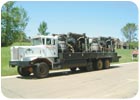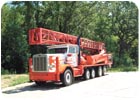
If you're thinking about doing a complete rebuild on one of your drill rigs, Mike Miller has this to say: “It's extremely time-consuming; you probably will come across more headaches than you thought you would.”
Miller is a driller with Kimmes-Bauer Inc., of Hastings, Minn. In business since 1980, Miller has been with the firm for 22 years. Kimmes-Bauer, with approximately 20 employees, runs two rigs - both Ingersoll-Rand TH-60s (1981 and 1984 models). “Our bread and butter is water wells - house wells, city wells - and irrigation wells, which, primarily, are agricultural, but we've also done some ballfields.”
The Project Begins
“This was an extreme total rebuild - new everything. Last February, we took the 1984 rig down to the bare frame,” Miller explains. “To get started, we added 3 feet under the frame and put all new axles under it, making it a six-wheel drive. That alone caused some headaches, getting everything to fit between the rear-end and the mast. We had to cut 7 inches out of the cab - that's why it looks short. We had to make our own space, so it's got a low-rider cab on it now. There's probably 3 inches of clearance between the engine rear-end and the cab - not a lot of room to play with; it's pretty tight. Then we got the axles mounted on it - the front has air-ride suspension, the back is rubber-mount. It was a tandem-axle truck; now it's a quad-axle. After that, we mounted the engine, tranny and cab.“The truck is a custom-built Peterbuilt 379 with an extender hood and a set-back front axle. Just about every part of it is custom-built. The cab is chopped and lowered. It has a 10-inch drop visor on it. The roof pan on top is wider than normal; that's so if you're working on the mast and mud drops, you're not getting it on your windshield or the side windows and mirrors.
“Then we did a bunch of upgrades on the drill rig itself,” he continues. “We rebuilt the mast, making it stronger. We added a custom-built swivel. That swivel is almost 10 years old and has the original bearings in it. We were going through swivels every two years. We now go through one-tenth the packing that we used to with the old swivel - it's definitely upgraded.”
Discussing some of the other modifications, Miller tells us, “We put hydraulic lift stands on it and a double retracting table. We had water-injection, but now it has foam-injection, too - all variable speed, so you can control it right from the panel. We also added oil-injection. We carry our foam right on the rig - we've got 70 gallons of foam and 70 gallons of rock oil - that saves a lot of refilling time. The tophead has been upgraded; the bearings in the top drive - that was done about a year after the swivel upgrade - have been performing for about eight years. We were getting 18 months or two years out of the old bearings.
“We modified the rod rack so it would hold more rods - 22. The rig has a lot more speed now. Winch speed, top head speed - everything has been increased. Our winch speed is 240 feet per minute; we can come out of the hole pretty fast.
“It's got a custom-built rod spinner on it. It's got a custom-built pipe clamp for welding joints - a single toggle switch runs the pipe clamp. I have yet to see a rod spinner that's easier to operate; it's like a second hand. It will go from 4-inch to 20-inch without doing anything. Actually, it will go down to 23⁄8-inch drill rod and up to 20-inch well casing without pulling pins, changing chucks or anything. It does it all. It's got remote control for the top-head, the air control and the winch. It's very user-friendly. The stands you stand on are nitrogen-filled, so they have some cushion to eliminate the jar to your body.”

The Small Details
“That's most of the major stuff,” Miller says. “There were a whole bunch of little things we did. Like the welded-on tape measure on the side of the mast - that comes in handy on a windy day when you're trying to hold the tape measure to set your casing at the right depth. We've got hammer holders wherever you might need a hammer. You don't have to look around - they're there. The rod spinner has two controls - one on the helper side and one on the operator side.“The front jacks were moved from the front of the truck to the sides. They're right in front of the wheels, so we didn't gain too much in length. The jack stands have extra-wide pads, so we don't have to lay down blocks and then dig them out. The front outriggers have controllers up front on the rig. If we need to get the front end blocked up higher, we don't have to run back and forth from one end of the rig to the other. Stuff like that just makes your life easier.” It took a lot of hard work and engineering to make life easier.
“It's got custom exhaust - the truck engine exhaust and the deck engine exhaust run through the same system,” Miller continues. “The deck engine and hydraulics used to sit inside the frame rails. We raised up everything a foot and pulled it ahead 2 feet; now you can stand by the hydraulic pumps and work on them instead of having to lay on your stomach and have someone hold your feet while you try to replace a hose. It's much more user-friendly now. All the wires are in junction boxes.”
The project - start to finish - took 17 weeks, seven days a week. “The most time-consuming part was the drive train,” Miller explains. “We had to build our own front end. Nobody built a front end that was low enough for the suspension, so we decided to go with air-ride. That alone took two weeks. It took another week to mount the axles. Everything adds up when you do a total rebuild. The only thing we have left to do is add an air-greaser to grease the tool joints.” He estimates that the total bill for the customization came to about $200,000.
“She's very fast and very efficient,” Miller says with pride. “I started this morning at 9:30, and I'm down 460 feet. I'm developing it now, and I'll be done by 4:30 p.m. Other drillers who've seen it up close are in awe; they don't even know what to say. It's definitely a showpiece. We knew what we wanted for the finished product.” Miller says he called one of the manufacturers to come and check out the work done on the rig. “They were going to redesign some of their stuff. They said they'd call me back but they still haven't,” he laments.
Looking Ahead
Asked what advice he'd give to other drilling contractors thinking about doing a total rebuild, he pauses just a bit, laughs and says, “Have somebody else do it.” Pressed, he continues: “You've got to plan it out. I've built trucks before, so I wasn't surprised at some of the things we encountered. I knew it was going to be a project. The boss maybe didn't think it would be such a project; it took a little bit more time than he thought it would to get everything right. But when it is done, there's a lot of satisfaction.“It's one thing building it in the shop; it's another thing putting it to the test. We've done about 200 wells since the rebuild was completed about a year ago. We've had no failures with anything we did, so it was done right. Production is what it's all about, and I'll put this rig up against anything else out there. I don't stand on the back of the rig thinking, 'I wish we did this or that differently.'”
That will serve Kimmes-Bauer well when it comes time to redo the 1981 rig. “That's our next project; it will go a lot faster,” Miller assures.
Report Abusive Comment